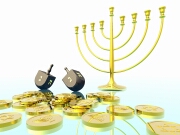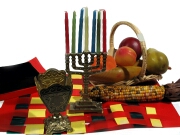The story of Christmas
Of course we all have our own books to read from to get the “facts”, but for the next few days prior to our blessed Holiday season I want to share with you guys a few cool paragraphs that sum it all up:) Enjoy
Origins of Christmas
 |
From the Old English ‘Cristes Mæsse’ ~ meaning the ‘mass of Christ’ ~ the story of Christmas begins with the birth of a babe in Bethlehem.
It is believed that Christ was born on the 25th, although the exact month is unknown. December was likely chosen so the Catholic Church could compete with rival pagan rituals held at that time of year and because of its closeness with the winter solstice in the Northern hemisphere, a traditional time of celebration among many ancient cultures. |
Luke, Chapter Two
And it came to pass in those days, that there went out a decree from Caesar Augustus, that all the world should be taxed. (And this taxing was first made when Cyrenius was governor of Syria.) And all went to be taxed, every one into his own city. And Joseph also went up from Galilee, out of the city of Nazareth, into Judaea, unto the city of David, which is called Bethlehem; (because he was of the house and lineage of David:) To be taxed with Mary his espoused wife, being great with child. And so it was, that, while they were there, the days were accomplished that she should be delivered. And she brought forth her firstborn son, and wrapped him in swaddling clothes, and laid him in a manger; because there was no room for them in the inn.
And there were in the same country shepherds abiding in the field, keeping watch over their flock by night. And, lo, the angel of the Lord came upon them, and the glory of the Lord shone round about them: and they were sore afraid. And the angel said unto them, “Fear not: for, behold, I bring you good tidings of great joy, which shall be to all people. For unto you is born this day in the city of David a Saviour, which is Christ the Lord. And this shall be a sign unto you; Ye shall find the babe wrapped in swaddling clothes, lying in a manger.” And suddenly there was with the angel a multitude of the heavenly host praising God, and saying, “Glory to God in the highest, and on earth peace, good will toward men.”
Hanukkah
 |
Commencing on the 25th day of the Hebrew month Kislev, Hanukkah is a Jewish holiday commemorating the rededication of the Holy Temple in Jerusalem after its desecration by the Syrians.
In 168 BC, members of the Jewish family Maccabee led a revolt against the Greek Syrians due to the policies of Syrian King Antiochus IV which were aimed at nullifying the Jewish faith. Part of this strategem included changing the Beit HaMikdash – the Holy Temple in Jerusalem – to a Greek temple complete with idolatry. Led by Judah Maccabee, the Jews won victory over the Syrians in 165 BC and reclaimed their temple. After cleansing the temple and preparing for its rededication, it was found there was not enough oil to light the N’er Tamid, an oil lamp present in Jewish houses of worship which represents eternal light. Once lit, the lamp should never be extinguished. |
A search of the temple produced a small vial of undefiled oil — enough for only one day. Miraculously, the Temple lights burned for eight days until a new supply of oil was brought. In remembrance of this miracle, one candle of the Menorah – an eight branched candelabra – is lit each of the eight days of Hanukkah. Hanukkah, which means dedication, is a Hebrew word when translated is commonly spelled Hanukah, Chanukah, and Hannukah due to different translations and customs.
The tradition of receiving gifts on each of the eight days of Hanukkah is relatively new and due in part to the celebration’s proximity to the Christmas season.
Kwanzaa
 |
Doctor Maulana Karenga, a Professor at California State University in Long Beach, California, created Kwanzaa in 1966. It is a holiday celebrated by millions of African-Americans around the world, encouraging them to remember their African heritage and consider their current place in America today. Kwanzaa is celebrated fom December 26 to January 1 and involves seven principles called Nguzo Saba: Umoja (Unity), Kujichagulia (Self-determination), Ujima (Collective Work and Responsibility), Ujamaa (Cooperative Economics), Nia (Purpose), Kuumba (Creativity), and Imani (Faith).
In the Kwanzaa ritual, seven candles called Mishumaa Saba are placed in a Kinara, or candleholder, which is then set upon the Mikeka, a mat usually made of straw. |
Three green candles are placed on the left, three red candles on the right and a black candle in the center, each candle representing one of the seven principles of the celebration. One candle is lit each day of the Kwanzaa celebration, beginning from left to right The colors of Kwanzaa ~ black, red and green ~ also have a special significance. Black symbolizes the faces of the African people, Red symbolizes the blood they have shed, and Green represents hope and the color of the motherland. The name itself – Kwanzaa – is a Swahili word meaning “fruits of the harvest.”
xxx
Brandi


















